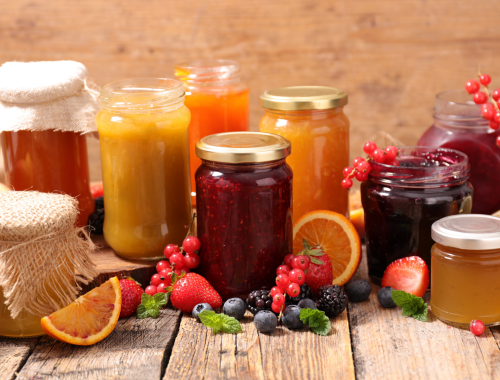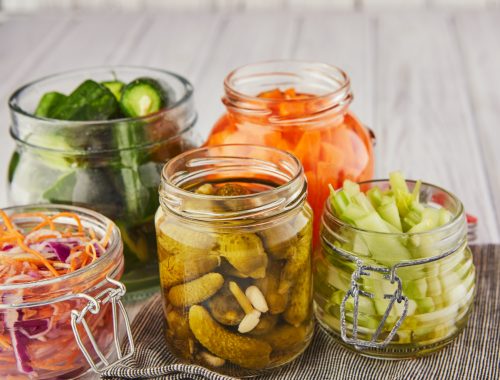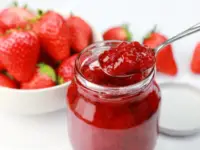
What is “Jam”?
The etymology of the word “jam” derives from the Middle English word “jamme,” which originally referred to a fruit and sugar mixture that was boiled to produce a thick, spreadable paste. “Jamme” is most likely derived from the Old French word “jamb,” which means “leg,” as the fruit and sugar mixture would resemble a thick leg bone in consistency. Throughout time, the term “jam” expanded to apply to any thick, spreadable product. Jams are made out from ground or crushed fruit and have thick consistency due to the high pectin (soluble fiber in fruits) concentration (Schafer et al., 2021).
The ingredients in making jam include fruit (i.e., apples, plums, and citrus), sugar, and pectin. As for the needed equipment, they include saucepan or a heavy-bottomed large pot, jam jar, and spatula or wooden spoon (Master Class, 2023).
The main steps in making jam include the following:
- Mash or cut the fruit into small pieces.
- Add sugar (the measurement is usually equal to the amount of fruit)
- Cook the fruit and sugar mixture over medium-high heat. Bring the mixture to a boil while stirring frequently. When it boils, reduce the heat to medium low and let it simmer until the mixture thickens.
- Test for doneness using the wrinkle test. Put a small amount on a chilled plate; push the jam with a finger. If it does not flow back and it wrinkles, it is ready.
- Store the jam in a sterilized bottle or jar.

What is “Preserves”?
The word “preserve” is derived from the Old French verb “preserver,” which means “to keep, save, or conserve,” and has since come to refer to the process of preparing jams, jellies, and other fruit preserves in order to prevent them from going bad. Preserves are chunks of fruits or vegetables that have been canned or jarred for long term storage.
The main steps in making preserves include the following (Singh & McLellan, 2021):
- Preserves are made by starting with an initial mixture that has a minimum of 45 parts fruit to 55 parts sugar solids by weight.
- After the fruit or vegetable is sliced, the sugar solids are added, and the mixture is then boiled. Cooking does not stop until the heated mixture has been concentrated to a specific quantity of soluble solids.
- After that, the product is put into containers and sealed to make it shelf-stable.
What are the Similarities between Jam and Preserves?
Similarity in Terms of Ingredients
Both jams and preserves use sugar and fruits and/or vegetables as the main ingredients.
Similarity in Terms of Procedure
In making jams and preserves, both involve cooking a mixture of fruits and sugar and storing them in sterilized containers.
Similarity in Terms of Use
Both of these sweet fruit spreads can be put on toast, yogurt, ice cream, and other desserts.
Similarity in Terms of Taste
Both of these spreads are sweet since one of their main ingredients is sugar.
Summary:
- Throughout time, the term “jam” expanded to apply to any thick, spreadable product.
- Preserves are chunks of fruits or vegetables that have been canned or jarred for long term storage.
- Both jams and preserves use sugar and fruits as the main ingredients; involve cooking a mixture of fruits and sugar; and can be used as toppings.
Frequently Asked Questions:
Are jam and preserves the same?
Though both jams and preserves use sugar and fruits as the main ingredients, involve cooking a mixture of fruits and sugar, and can be used as toppings, they are not the same. Jams have a smooth and consistent texture while preserves are made with larger fruit pieces in a syrupy and thick mixture.
What are the similarities of jam and jelly?
Both jams and jellies are sweet and may be put on top of toast, pastries, and other desserts. Their ingredients include fruit, sugar, water, and pectin.
What is the similarity and difference between marmalade and jam?
Both marmalades and jams are sweet, used as spreads, and can be made from a variety of fruits. They also have a thick texture and can be stored for long periods of time. Regarding their differences, marmalades are typically made out of oranges and have chunkier textures since citrus peelings are included. On the other hand, jams can be made out of various fruits and have smoother and more consistent thick textures.
What is similar to jam?
The following are similar to jam based on their consistencies, taste, and ingredients:
- Preserves- These are made out of larger pieces of fruits and sugar.
- Jellies- These are fruit spreads out of fruits or fruit juice and sugar.
- Fruit butter- This spread is smooth and creamy; it is also cooked fruit and sugar.
- Marmalades- These are made out of citrus fruit (generally oranges) and sugar; they have chunkier textures due to the inclusion of citrus peelings.
- Compotes- These fruit sauces which sometimes contain spices have consistencies which are usually thinner than that of jams.
Which is thicker, jams or preserves?
Jams are cooked crushed or mashed fruit and sugar. They have a smooth and consistent texture. As for preserves, they are made with larger fruit pieces in a syrupy and thick mixture.
Which is better jam or preserves?
If you prefer spreads with smoother and consistent textures, you may tend to think that jams are better. However, if you prefer spreads with larger fruit pieces suspended in a syrupy and thick mixture, you may tend to think that preserves are better.
What is the difference between jam sugar and preserving sugar?
As its name suggests, “jam sugar” is made specifically for jam-making. It contains pectin, a naturally occurring thickening present in many fruits, and occasionally also contains citric acid to aid in jam setting. On the other hand, preserves, which are fruit spreads created with larger bits of fruit, are made with preserving sugar. Larger sugar crystals found in preserving sugar dissolve more slowly than those found in conventional granulated sugar, aiding in the preservation of the fruit pieces. This kind of sugar, depending on the brand, may also contain pectin.









Leave a Reply